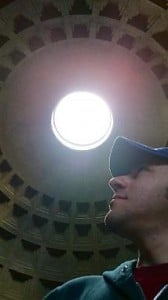I had never heard of the Fulbright U.S. Student Program until three months before I applied. In the summer of 2009, I knew I would graduate from college in just a few short months, and was still considering options for the future. Then, I received a letter in the mail from my university about an opportunity to travel to a different country and learn about its culture while conducting research.
I contacted my school’s Fulbright Program Adviser and discovered a grant in Italy specifically for engineering graduate study at the Politecnico di Torino. I had always had an interest in Italian culture, and had studied the language in high school. While putting my application together, with the help of my Fulbright Program Adviser and some other members of the faculty, I contacted the Politecnico di Torino describing my desire to study with them. Politecnico then gave me details on the coursework they offered and how to apply. The application took a lot of time – it’s not something you can do in one sitting. I spent a great deal of time researching the school and Turin, Italy, before writing and meticulously tweaking my essays.
In 2000, before I graduated from high school, I enlisted in the United States Air Force. I hadn’t yet picked a career, but one day, the captain of my squadron called me into his office to receive a new assignment—I would start construction training at a new base the next morning. After my training and assignment ended in 2004, I took off my uniform as a Senior Airman and returned to my home on Long Island with a growing passion for construction. I enrolled in a civil engineering and construction management program at Nassau Community College. A few years later, I finished my B.S. in Construction Management Engineering Technology from Farmingdale State College.
The next fall, after receiving a Fulbright U.S. Student Program award, I arrived in Turin to spend two semesters studying at the Politecnico di Torino. My studies focused on the construction and design of bridges, asphalt and concrete pavements, railways, and airport runways, with graduate coursework in civil engineering. I lived in an apartment building for international students provided by the school. The building was full of students from Europe, Asia, and South America. I also studied not only with Italians, but with students from around the world. This gave me a fascinating insight into how other foreign nationals adapted to Italian culture. We debated the best places to eat and learned to adapt our daily routine to schools and offices being closed for four-hour lunch breaks.
I learned about European construction and design methods, and frequently discussed similarities and differences compared to those in the United States with my fellow students and professors. Living in Italy allowed me to visit many architectural landmarks, including the Pantheon in Rome. I traveled to different regions of Italy with my friends from school – especially Leonardo, who was also studying bridge design. Leonardo was also a stranger to Turin – he was from Sicily – so we explored the city together. He invited me to stay at his home in Messina for the Easter holiday, where I had fantastic food and experienced my first earthquake!
When I returned from Italy, I applied the credits I earned at the Politecnico di Torino to my master’s program in construction management at the Polytechnic Institute of New York University. While I finished school, I brought the lessons I’d learned in Italy back to my predominantly Italian-American home community on Long Island as a project consultant. And, after I finished my master’s degree, I took my knowledge and skills to a new job in Lubbock, Texas. I’ll soon be packing up and moving again to start my next project in another part of the country.
My exchange experience as a Fulbright Student helped me develop the skills I need to adapt to life in diverse environments. What will your Fulbright do for you?
Some tips for applicants:
- Get in contact with whomever you hope to be affiliated and work with and put together your project’s details as soon as possible.
- Discuss your project, past research and studies using language that can be understood by any reader. If your project is outlined using language that is too technical, it will be difficult to understand.
- Putting together your application will take a great deal of time; it will require much research and tweaking.


2 Comments
Hey Jared,
I am delighted to see that you are now a Fulbright Ambassador…..and that your career is taking off. Do stay in touch with Famringdale and let us know what/where you go next.
sincerely,
Bev Kahn